|
Velojet 50 and 100 – New Zealand challengers |
|

 Illustration source:
Aeromodeller,
Illustration source:
Aeromodeller,
March 1955,
"Trade Notes"
|
 |
In March 1953,
Aeromodeller hailed the arrival of the New Zealand designed and manufactured
Velojet 50 and its larger sibling, the Velojet 100, in the following favourable
review:
Motor Mart
announced the existence of a New Zealand Velojet 50 unit last month, and we have now
had the pleasure of testing a sample. Price in N.Z. is 13s. for the 50, complete with
five pellets, wick, gauze and screw mounting clip, and for export this is reduced to us.
A 100 unit is 22s. 6d. in N.Z. — and the same price export. Turned from the solid,
it has many new features. The safety pressure release is at the front in the form
of a disc against a pre-tensioned coil spring, and the screw cap is very easy to re-fit
after loading. Constant use and corrosion make the cap difficult to unscrew
without use of ill-advised pliers. Mounting in an "L" shaped bracket is simple.
It is a very powerful, well-made job, manufactured by the Betta Model Aeroplane Supply
Co., New Plymouth, N.Z.
|
|

|
Tiger Rockety Type A – a Japanese Jetex 50 clone |
|
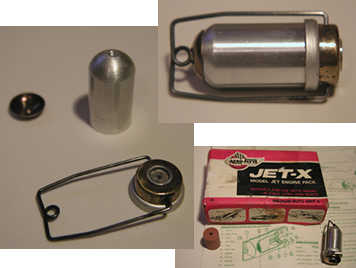
The Type A motor illustrated here used Jetex Red Spot fuel.
There was also a Type B (100 equivalent) motor. Both models were dimensional copies of their Jetex counterparts.
The manufacturer was
Tiger Manufacturing Inc., 3-1-16 Rokugo, Otaku, Tokyo, Zip 144.
|
 |
Ben Nead, owner of the Tiger Rockety Type A pictured here, says of it:
"[My example was] distributed in Australia by Aero-Flyte Products Pty Ltd, Panorama, SA and, curiously, carries the name 'Jet-X' on
the box. I have
seen photos of mint copies of the same motor on ebay
but with Japanese labeled packaging.
"Mine was originally
purchased by a US serviceman stationed in Australia in the late 60s / early 70s. He
bought it in a local hobby shop, fired
it once, but didn't clean it afterwards.
"The entire thing was almost black when I got it. With the help of a
jeweller, I gave it the cleaning of its life. The aft closure cap was
completely covered in black soot and rust which soon gave way
to pitted brass. A mint condition copy of this motor would have
this brass area finished with an electroplating of dark brown
(as opposed to bright red) copper based material.
"The level of workmanship is really
extraordinary. Notice that when it is disassembled, the small dark copper disc comes off
the end of the aluminum casing. The nozzle is supposed to have this copper
plating on it as well. You can
clearly see the pitted brass underneath where this copper plating was
supposed to be."
|

|
 |
 |
Bill Henderson contributed these photos of his Tiger Rockety Type A motor, now in the possession of Jetex.org owner/manager Ben Nead.
A special feature of the Tiger Rockety motor was the light aluminium tubular heat shield to protect the model. Note also the hollow central core of the fuel pellets, intended to promote speedier ignition.
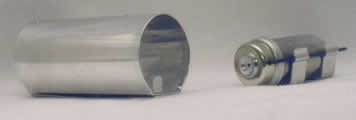
|
 |
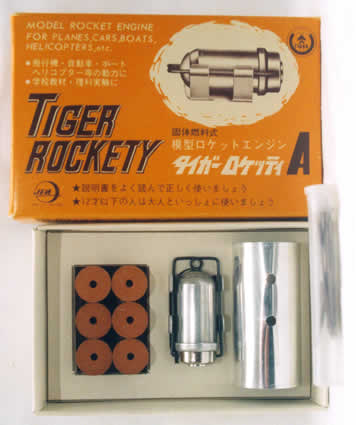
|
 |
 |
Tiger Rockety Type B – a Japanese Jetex 100 clone
|
|
 |
 |
Bill Henderson contributed these photos of his Tiger Rockety Type B motor, now in the possession of Jetex.org owner/manager Ben Nead.
Like the Tiger Rockety A motor, it also came with a light aluminium tubular heat shield and cored pellets. A further feature of the Type B motor was its mounting clip which kept the motor firmly in place and made thrust adjustments very easy.
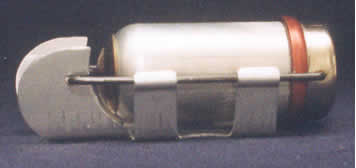

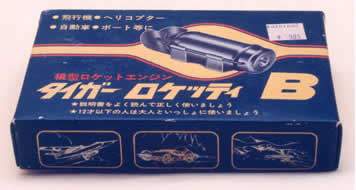

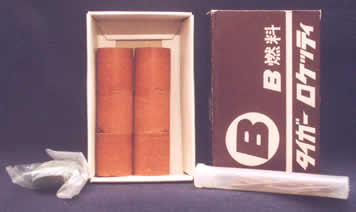
|
|
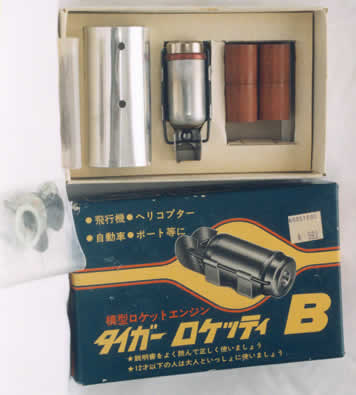

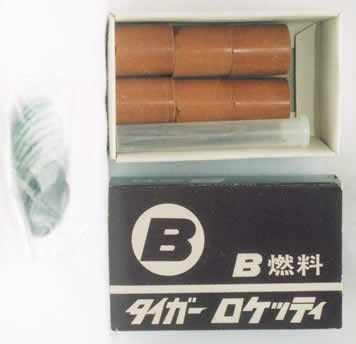
|
 |
more >>
|
 |

|
Nova-Jet – Austrian simplicity
|
|

Jim asked:
"Has anybody ever seen the Nova-Jet aeroplane?"
… and Steve Lawrie
sent us this reply:
"Back in the early 60's,
I remember my dad bringing us back two of these planes from a business trip in Europe.
We lived in Johannesburg, South Africa.
"My brother and I each were given a Nova-Jet in its box. I remember it as being made
of white, fairly dense polystyrene foam and was definitely the first molded foam
airplane we had ever seen. It was probably 9 inches long with a span only slightly
smaller. It came with a hand-held catapult whose elastic sling you hitched
to a catch under the nose. The thing flew quite well (but lacked lateral stability)
on the catapult alone.
"I think that the motors were already mounted on the top
middle section of the planes when we removed them from their boxes. I distinctly
remember their shiny aluminium-like feel and appearance: just two parts, the chanmber
and threaded nozzle. The original package did not include any fuel pellets
for these motors, but they worked with Jetex pellets."
|
Chris Krizek bought one in 1954 in Vienna from the Austrian aeromodelling supplies company Sperl (in the Wiedner Hauptstrasse, then in the British sector of Vienna). To his knowledge, Sperl were the makers of the Nova-Jet (or had it locally manufactured for them). The packaging mentioned no patents and had no other trade marks. As Chris recalls, “It was quite primitive and heavy and much cheaper than a Jetex unit but suited my financial status and the only fuel available were Jetex 50 pellets.”
|
 |
Jim Fackert,
owner of the Nova-Jet motor pictured here, says of it:
"The Nova-Jet
apparently was a delta winged elastic catapult launched glider that
optionally flew with a Jetex-like engine [pictured].
I have the engine and some fuel pellets, but no airplane, and no pictures of
it.
"The fuel pellets were made in Germany, and I
suspect that the whole plane may have been made there…
"The engine is interesting in that it has a threaded-on nozzle and pressure
relief port on the front with a dimpled disk spring that seals the port.
It's a fairly hefty aluminum body with an acme threaded aluminum nozzle cap
and a steel nozzle liner eyelet riveted in."
|
The original instruction sheet was in badly worn condition (see photograph) but Jim has painstakingly restored the text. An extract is reproduced below; the full text is available on a separate page.
FILLING THE JET ENGINE
- Insert the jet fuel pellet (b) all the way into the chamber (a).
- Push the fuse (e) through the jet nozzle (d) and bend it a little, do not break it, at the interior end as shown in the above diagram.
- Screw the cap (c) onto the chamber tightly to avoid gas leakage and push the extending fuse into the chamber so that approximately only 1/4 inch of the fuse protrudes from the jet nozzle. By this method, the fuse is assured perfect contact with the jet fuel, and false ignitions can be avoided.
- Light the fuse and launch the plane as described above.
|
|

|
 |
 |
 |
|
Motox 12 – German simplicity
|
|
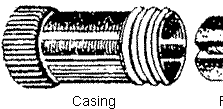
 This micro rocket motor, which bears a striking resemblance to the Nova-Jet, appeared in John Emmett's
'Jetex Natters' in the October 1992 issue of SAM35 Speaks.
This micro rocket motor, which bears a striking resemblance to the Nova-Jet, appeared in John Emmett's
'Jetex Natters' in the October 1992 issue of SAM35 Speaks.
John introduced it with this comment:
"John Nesbitt kindly lent me one of these motor outputs, which I
have to admit I had never heard of. Quite tiny, with 11mm bore,
it has black waxy pellets and wick which is not unlike early
Jetex, although it has been dipped rather than extruded. Notable
is the lack of a mounting clip, and absolutely no safety vent in
the event of a blocked nozzle. Wouldn't that enliven those few
silent seconds after you lit the fuse!"
|
We have the complete
German
instruction sheet.
Here are translated excerpts:
Instructions for the Motox 12 Jet Propulsion Unit
Our Motox 12 Jet Propulsion Unit has been developed to power our "Star" jet
aeroplane.
1. The fuel pellet of our Motox 12 is very easy to ignite […]
The principal ingredient of our Motox 12 fuel has absolutely no resemblance
to black powder or any other explosive material. The fuel pellet should not
be ignited indoors and is intended only for use in open spaces.
2. The Motox 12 must be loaded strictly in accordance with the directions given
below. […]
3. The combustion of the fuel causes the Motox 12 to become hot and so it should
not be handled immediately afterwards. […]
Directions for the Motox 12
The fuel pellet must be fully inserted into the motor casing. Approximately
4 cm of fuse can then be inserted through the nozzle, in such a way that 1 cm
protrudes from the nozzle, with 3 cm inside. […]
We wish you many enjoyable flights!
Motox Toy Company, Düsselforf - Bremen
|
|

-
SAM35 Speaks (Jetex Natters), Oct. 1992, p. 134
|

|
|
|